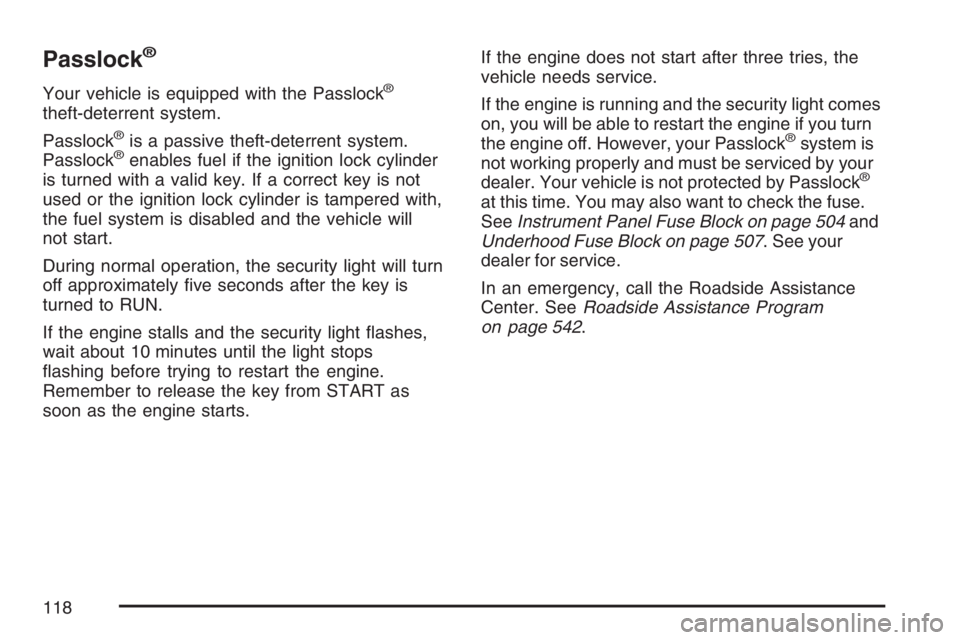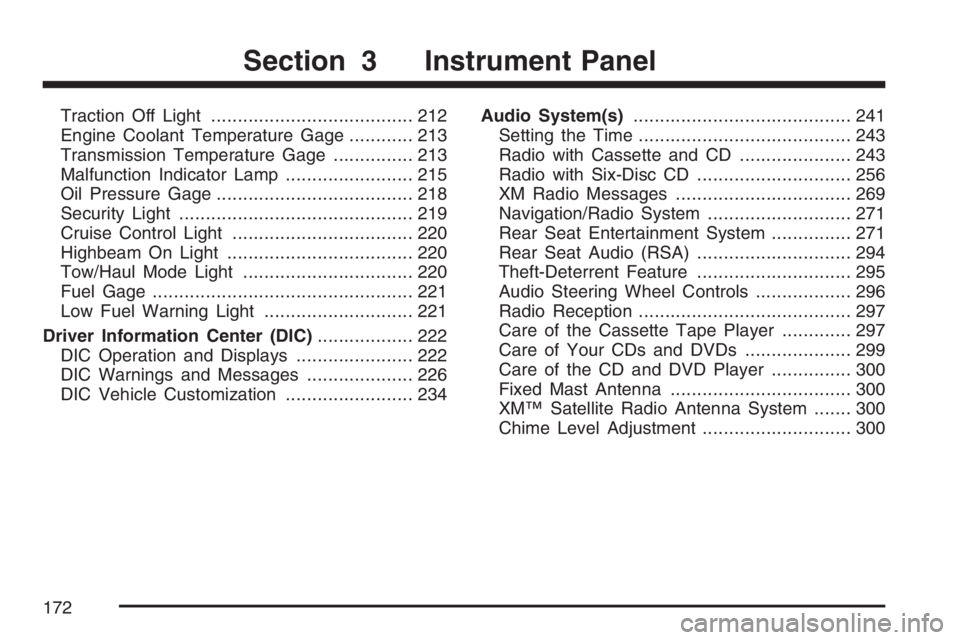2007 HUMMER H2 fuel
[x] Cancel search: fuelPage 1 of 570

Seats and Restraint Systems
....................... 7
Front Seats
.............................................. 8
Rear Seats
............................................. 15
Safety Belts
............................................ 24
Child Restraints
...................................... 46
Airbag System
........................................ 77
Restraint System Check
......................... 90
Features and Controls
................................ 93
Keys
....................................................... 95
Doors and Locks
.................................. 100
Windows
............................................... 111
Theft-Deterrent Systems
....................... 115
Starting and Operating Your Vehicle
....... 119
Mirrors
.................................................. 139
OnStar
®System
................................... 144
Universal Home Remote System
.......... 148
Storage Areas
...................................... 160
Sunroof
................................................ 168Instrument Panel
....................................... 171
Instrument Panel Overview
................... 174
Climate Controls
................................... 197
Warning Lights, Gages, and
Indicators
.......................................... 204
Driver Information Center (DIC)
............ 222
Audio System(s)
................................... 241
Driving Your Vehicle
................................. 301
Your Driving, the Road, and
Your Vehicle
..................................... 302
Towing
................................................. 369
Service and Appearance Care
.................. 389
Service
................................................. 392
Fuel
...................................................... 394
Checking Things Under the Hood
......... 400
Rear Axle
............................................. 437
Four-Wheel Drive
.................................. 438
Front Axle
............................................ 440
2007 HUMMER H2 Owner ManualM
1
Page 118 of 570

Passlock®
Your vehicle is equipped with the Passlock®
theft-deterrent system.
Passlock
®is a passive theft-deterrent system.
Passlock®enables fuel if the ignition lock cylinder
is turned with a valid key. If a correct key is not
used or the ignition lock cylinder is tampered with,
the fuel system is disabled and the vehicle will
not start.
During normal operation, the security light will turn
off approximately �ve seconds after the key is
turned to RUN.
If the engine stalls and the security light �ashes,
wait about 10 minutes until the light stops
�ashing before trying to restart the engine.
Remember to release the key from START as
soon as the engine starts.If the engine does not start after three tries, the
vehicle needs service.
If the engine is running and the security light comes
on, you will be able to restart the engine if you turn
the engine off. However, your Passlock
®system is
not working properly and must be serviced by your
dealer. Your vehicle is not protected by Passlock
®
at this time. You may also want to check the fuse.
SeeInstrument Panel Fuse Block on page 504and
Underhood Fuse Block on page 507. See your
dealer for service.
In an emergency, call the Roadside Assistance
Center. SeeRoadside Assistance Program
on page 542.
118
Page 123 of 570

Engine Coolant Heater
Your vehicle may be equipped with an engine
coolant heater.
In very cold weather, 0°F (−18°C) or colder, the
engine coolant heater can help. You will get easier
starting and better fuel economy during engine
warm-up.
Usually, the coolant heater should be plugged in a
minimum of four hours prior to starting your
vehicle. At temperatures above 32°F (0°C), use of
the coolant heater is not required. Your vehicle
may also have an internal thermostat in the
plug end of the cord. This will prevent operation of
the engine coolant heater when the temperature
is at or above 0°F (-18°C) as noted on the cord.
To Use the Engine Coolant Heater
1. Turn off the engine.
2. Locate the electrical cord near the front
recovery loop on the driver’s side of the
vehicle.
3. Plug it into a normal, grounded 110-volt AC
outlet.
{CAUTION:
Plugging the cord into an ungrounded
outlet could cause an electrical shock.
Also, the wrong kind of extension cord
could overheat and cause a �re. You
could be seriously injured. Plug the cord
into a properly grounded three-prong
110-volt AC outlet. If the cord will not
reach, use a heavy-duty three-prong
extension cord rated for at least 15 amps.
4. Before starting the engine, be sure to unplug
and store the cord as it was before to keep it
away from moving engine parts. If you do
not, it could be damaged.
How long should you keep the coolant heater
plugged in? The answer depends on the outside
temperature, the kind of oil you have, and
some other things. Instead of trying to list
everything here, we ask that you contact your
dealer in the area where you will be parking your
vehicle. The dealer can give you the best
advice for that particular area.
123
Page 126 of 570

DRIVE (D):This position is for normal driving. It
provides the best fuel economy for your vehicle. If
you need more power for passing, and you are:
Going less than about 35 mph (55 km/h),
push your accelerator pedal about
halfway down.
Going about 35 mph (55 km/h) or more, push
the accelerator all the way down.
You will shift down to the next gear and have
more power.
Downshifting the transmission in slippery road
conditions could result in skidding, see “Skidding”
underLoss of Control on page 316.
DRIVE (D) can be used when towing a trailer,
carrying a heavy load, driving on steep hills or for
off-road driving. You may want to shift the
transmission to THIRD (3) or, if necessary, a lower
gear selection if the transmission shifts too often.THIRD (3):This position is used for normal
driving. It reduces vehicle speed more than
DRIVE (D) without using your brakes. You might
choose THIRD (3) instead of DRIVE (D) when
driving on hilly, winding roads, when towing
a trailer, so there is less shifting between gears
and when going down a steep hill.
SECOND (2):This position reduces vehicle speed
even more than THIRD (3) without using your
brakes. You can use SECOND (2) on hills. It can
help control your speed as you go down steep
mountain roads, but then you would also want to
use your brakes off and on.
If you manually select SECOND (2), the
transmission will drive in second gear. You may
use this feature for reducing the speed of the rear
wheels when you are trying to start your vehicle
from a stop on slippery road surfaces. Once
the vehicle is moving, shift into DRIVE (D).
126
Page 172 of 570

Traction Off Light...................................... 212
Engine Coolant Temperature Gage............ 213
Transmission Temperature Gage............... 213
Malfunction Indicator Lamp........................ 215
Oil Pressure Gage..................................... 218
Security Light............................................ 219
Cruise Control Light.................................. 220
Highbeam On Light................................... 220
Tow/Haul Mode Light................................ 220
Fuel Gage................................................. 221
Low Fuel Warning Light............................ 221
Driver Information Center (DIC).................. 222
DIC Operation and Displays...................... 222
DIC Warnings and Messages.................... 226
DIC Vehicle Customization........................ 234Audio System(s)......................................... 241
Setting the Time........................................ 243
Radio with Cassette and CD..................... 243
Radio with Six-Disc CD............................. 256
XM Radio Messages................................. 269
Navigation/Radio System........................... 271
Rear Seat Entertainment System............... 271
Rear Seat Audio (RSA)............................. 294
Theft-Deterrent Feature............................. 295
Audio Steering Wheel Controls.................. 296
Radio Reception........................................ 297
Care of the Cassette Tape Player............. 297
Care of Your CDs and DVDs.................... 299
Care of the CD and DVD Player............... 300
Fixed Mast Antenna.................................. 300
XM™ Satellite Radio Antenna System....... 300
Chime Level Adjustment............................ 300
Section 3 Instrument Panel
172
Page 205 of 570

Instrument Panel Cluster
Your instrument cluster is designed to let you know at a glance how your vehicle is running. You will
know how fast you are going, about how much fuel you have and many other things you will need to know
to drive safely and economically.
United States version shown, Canada similar
205
Page 215 of 570

Malfunction Indicator Lamp
Check Engine Light
Your vehicle has a
computer which
monitors operation
of the fuel, ignition,
and emission
control systems.
This system is called OBD II (On-Board
Diagnostics-Second Generation) and is intended
to assure that emissions are at acceptable
levels for the life of the vehicle, helping to produce
a cleaner environment. The check engine light
comes on to indicate that there is a problem and
service is required. Malfunctions often will be
indicated by the system before any problem is
apparent. This may prevent more serious damage
to your vehicle. This system is also designed to
assist your service technician in correctly
diagnosing any malfunction.Notice:If you keep driving your vehicle with
this light on, after awhile, your emission
controls may not work as well, your fuel
economy may not be as good, and your engine
may not run as smoothly. This could lead to
costly repairs that may not be covered by your
warranty.
Notice:Modi�cations made to the engine,
transmission, exhaust, intake, or fuel system
of your vehicle or the replacement of the
original tires with other than those of the same
Tire Performance Criteria (TPC) can affect
your vehicle’s emission controls and may
cause this light to come on. Modi�cations to
these systems could lead to costly repairs not
covered by your warranty. This may also
result in a failure to pass a required Emission
Inspection/Maintenance test. SeeAccessories
and Modifications on page 392.
215
Page 217 of 570

If the Light Is On Steady
You may be able to correct the emission system
malfunction by considering the following:
Did you recently put fuel into your vehicle?
If so, reinstall the fuel cap, making sure to fully
install the cap. SeeFilling the Tank on page 397.
The diagnostic system can determine if the
fuel cap has been left off or improperly installed.
A loose or missing fuel cap will allow fuel to
evaporate into the atmosphere. A few driving trips
with the cap properly installed should turn the
light off.
Did you just drive through a deep puddle of water?
If so, your electrical system may be wet. The
condition will usually be corrected when the
electrical system dries out. A few driving trips
should turn the light off.Have you recently changed brands of fuel?
If so, be sure to fuel your vehicle with quality fuel.
SeeGasoline Octane on page 394. Poor fuel
quality will cause your engine not to run as
efficiently as designed. You may notice this as
stalling after start-up, stalling when you put
the vehicle into gear, mis�ring, hesitation on
acceleration, or stumbling on acceleration. (These
conditions may go away once the engine is
warmed up.) This will be detected by the system
and cause the light to turn on.
If you experience one or more of these conditions,
change the fuel brand you use. It will require at
least one full tank of the proper fuel to turn the
light off.
If none of the above steps have made the light
turn off, your dealer can check the vehicle.
Your dealer has the proper test equipment and
diagnostic tools to �x any mechanical or electrical
problems that may have developed.
217